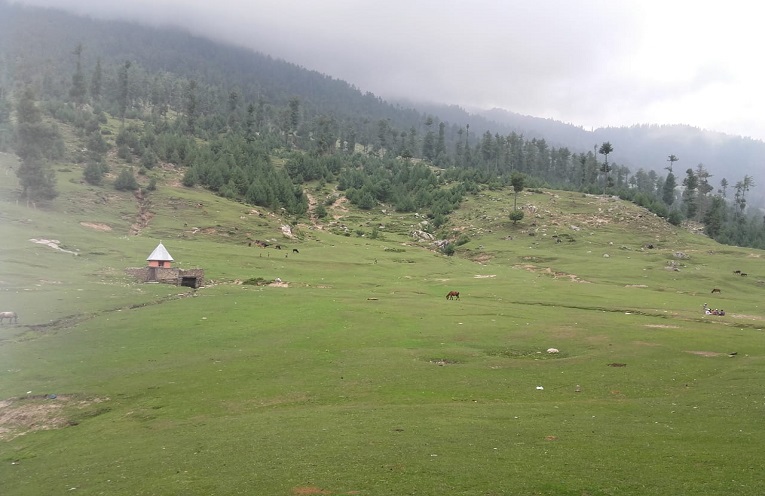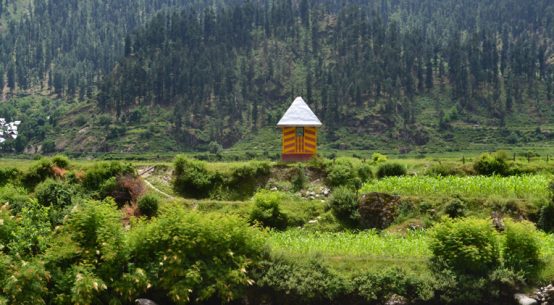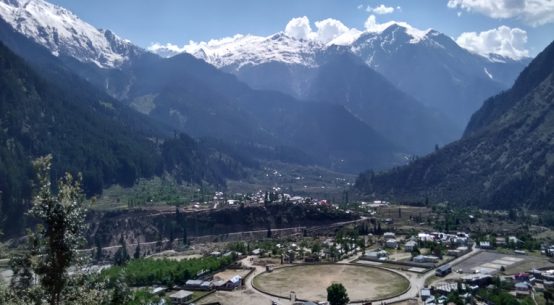
TEHSILWISE POPULATION AS PER CENSUS- 2011
| S.No. | Tehsil | Households | Population | Male | Female |
| 1 | Bonjwah | 2798 | 15899 | 8205 | 7694 |
List of all towns and Villages in Bonjwah Tehsil of Kishtwar district, Jammu and Kashmir. Complete details of Population, Religion, Literacy and Sex Ratio in tabular format.
Benun Population – Kishtwar, Jammu and Kashmir
Benun is a medium size village located in Kishtwar of Kishtwar district, Jammu and Kashmir with total 268 families residing. The Benun village has population of 1536 of which 811 are males while 725 are females as per Population Census 2011.
In Benun village population of children with age 0-6 is 277 which makes up 18.03 % of total population of village. Average Sex Ratio of Benun village is 894 which is higher than Jammu and Kashmir state average of 889. Child Sex Ratio for the Benun as per census is 799, lower than Jammu and Kashmir average of 862.
Benun village has lower literacy rate compared to Jammu and Kashmir. In 2011, literacy rate of Benun village was 56.95 % compared to 67.16 % of Jammu and Kashmir. In Benun Male literacy stands at 75.19 % while female literacy rate was 37.04 %.
As per constitution of India and Panchyati Raaj Act, Benun village is administrated by Sarpanch (Head of Village) who is elected representative of village.
Benun Data
| Particulars | Total | Male | Female |
|---|---|---|---|
| Total No. of Houses | 268 | – | – |
| Population | 1,536 | 811 | 725 |
| Child (0-6) | 277 | 154 | 123 |
| Schedule Caste | 63 | 35 | 28 |
| Schedule Tribe | 93 | 48 | 45 |
| Literacy | 56.95 % | 75.19 % | 37.04 % |
| Total Workers | 812 | 414 | 398 |
| Main Worker | 324 | 0 | 0 |
| Marginal Worker | 488 | 230 | 258 |
Caste Factor
Work Profile
Jirwar Population – Kishtwar, Jammu and Kashmir
Jirwar is a medium size village located in Kishtwar of Kishtwar district, Jammu and Kashmir with total 60 families residing. The Jirwar village has population of 403 of which 193 are males while 210 are females as per Population Census 2011.
In Jirwar village population of children with age 0-6 is 77 which makes up 19.11 % of total population of village. Average Sex Ratio of Jirwar village is 1088 which is higher than Jammu and Kashmir state average of 889. Child Sex Ratio for the Jirwar as per census is 1406, higher than Jammu and Kashmir average of 862.
Jirwar village has lower literacy rate compared to Jammu and Kashmir. In 2011, literacy rate of Jirwar village was 61.96 % compared to 67.16 % of Jammu and Kashmir. In Jirwar Male literacy stands at 83.23 % while female literacy rate was 41.21 %.
As per constitution of India and Panchyati Raaj Act, Jirwar village is administrated by Sarpanch (Head of Village) who is elected representative of village.
Jirwar Data
| Particulars | Total | Male | Female |
|---|---|---|---|
| Total No. of Houses | 60 | – | – |
| Population | 403 | 193 | 210 |
| Child (0-6) | 77 | 32 | 45 |
| Schedule Caste | 25 | 11 | 14 |
| Schedule Tribe | 0 | 0 | 0 |
| Literacy | 61.96 % | 83.23 % | 41.21 % |
| Total Workers | 110 | 88 | 22 |
| Main Worker | 27 | 0 | 0 |
| Marginal Worker | 83 | 63 | 20 |
Caste Factor
Work Profile
Kewah Population – Kishtwar, Jammu and Kashmir
Kewah is a medium size village located in Kishtwar of Kishtwar district, Jammu and Kashmir with total 322 families residing. The Kewah village has population of 1852 of which 949 are males while 903 are females as per Population Census 2011.
In Kewah village population of children with age 0-6 is 403 which makes up 21.76 % of total population of village. Average Sex Ratio of Kewah village is 952 which is higher than Jammu and Kashmir state average of 889. Child Sex Ratio for the Kewah as per census is 1099, higher than Jammu and Kashmir average of 862.
Kewah village has lower literacy rate compared to Jammu and Kashmir. In 2011, literacy rate of Kewah village was 54.59 % compared to 67.16 % of Jammu and Kashmir. In Kewah Male literacy stands at 68.96 % while female literacy rate was 38.87 %.
As per constitution of India and Panchyati Raaj Act, Kewah village is administrated by Sarpanch (Head of Village) who is elected representative of village.
Kewah Data
| Particulars | Total | Male | Female |
|---|---|---|---|
| Total No. of Houses | 322 | – | – |
| Population | 1,852 | 949 | 903 |
| Child (0-6) | 403 | 192 | 211 |
| Schedule Caste | 135 | 77 | 58 |
| Schedule Tribe | 569 | 291 | 278 |
| Literacy | 54.59 % | 68.96 % | 38.87 % |
| Total Workers | 423 | 388 | 35 |
| Main Worker | 172 | 0 | 0 |
| Marginal Worker | 251 | 235 | 16 |
Caste Factor
Work Profile
Kither Population – Kishtwar, Jammu and Kashmir
Kither is a medium size village located in Kishtwar of Kishtwar district, Jammu and Kashmir with total 153 families residing. The Kither village has population of 861 of which 451 are males while 410 are females as per Population Census 2011.
In Kither village population of children with age 0-6 is 155 which makes up 18.00 % of total population of village. Average Sex Ratio of Kither village is 909 which is higher than Jammu and Kashmir state average of 889. Child Sex Ratio for the Kither as per census is 987, higher than Jammu and Kashmir average of 862.
Kither village has lower literacy rate compared to Jammu and Kashmir. In 2011, literacy rate of Kither village was 39.24 % compared to 67.16 % of Jammu and Kashmir. In Kither Male literacy stands at 55.23 % while female literacy rate was 21.32 %.
As per constitution of India and Panchyati Raaj Act, Kither village is administrated by Sarpanch (Head of Village) who is elected representative of village.
Kither Data
| Particulars | Total | Male | Female |
|---|---|---|---|
| Total No. of Houses | 153 | – | – |
| Population | 861 | 451 | 410 |
| Child (0-6) | 155 | 78 | 77 |
| Schedule Caste | 0 | 0 | 0 |
| Schedule Tribe | 549 | 289 | 260 |
| Literacy | 39.24 % | 55.23 % | 21.32 % |
| Total Workers | 453 | 229 | 224 |
| Main Worker | 451 | 0 | 0 |
| Marginal Worker | 2 | 1 | 1 |
Caste Factor
Work Profile
Mori Population – Kishtwar, Jammu and Kashmir
Mori is a medium size village located in Kishtwar of Kishtwar district, Jammu and Kashmir with total 314 families residing. The Mori village has population of 1547 of which 814 are males while 733 are females as per Population Census 2011.
In Mori village population of children with age 0-6 is 311 which makes up 20.10 % of total population of village. Average Sex Ratio of Mori village is 900 which is higher than Jammu and Kashmir state average of 889. Child Sex Ratio for the Mori as per census is 920, higher than Jammu and Kashmir average of 862.
Mori village has lower literacy rate compared to Jammu and Kashmir. In 2011, literacy rate of Mori village was 38.75 % compared to 67.16 % of Jammu and Kashmir. In Mori Male literacy stands at 52.61 % while female literacy rate was 23.29 %.
As per constitution of India and Panchyati Raaj Act, Mori village is administrated by Sarpanch (Head of Village) who is elected representative of village.
Mori Data
| Particulars | Total | Male | Female |
|---|---|---|---|
| Total No. of Houses | 314 | – | – |
| Population | 1,547 | 814 | 733 |
| Child (0-6) | 311 | 162 | 149 |
| Schedule Caste | 0 | 0 | 0 |
| Schedule Tribe | 1,035 | 547 | 488 |
| Literacy | 38.75 % | 52.61 % | 23.29 % |
| Total Workers | 668 | 375 | 293 |
| Main Worker | 452 | 0 | 0 |
| Marginal Worker | 216 | 48 | 168 |
Caste Factor
Work Profile
Nali Population – Kishtwar, Jammu and Kashmir
Nali is a medium size village located in Kishtwar of Kishtwar district, Jammu and Kashmir with total 241 families residing. The Nali village has population of 1333 of which 682 are males while 651 are females as per Population Census 2011.
In Nali village population of children with age 0-6 is 254 which makes up 19.05 % of total population of village. Average Sex Ratio of Nali village is 955 which is higher than Jammu and Kashmir state average of 889. Child Sex Ratio for the Nali as per census is 881, higher than Jammu and Kashmir average of 862.
Nali village has lower literacy rate compared to Jammu and Kashmir. In 2011, literacy rate of Nali village was 63.58 % compared to 67.16 % of Jammu and Kashmir. In Nali Male literacy stands at 79.71 % while female literacy rate was 46.99 %.
As per constitution of India and Panchyati Raaj Act, Nali village is administrated by Sarpanch (Head of Village) who is elected representative of village.
Nali Data
| Particulars | Total | Male | Female |
|---|---|---|---|
| Total No. of Houses | 241 | – | – |
| Population | 1,333 | 682 | 651 |
| Child (0-6) | 254 | 135 | 119 |
| Schedule Caste | 0 | 0 | 0 |
| Schedule Tribe | 70 | 37 | 33 |
| Literacy | 63.58 % | 79.71 % | 46.99 % |
| Total Workers | 394 | 338 | 56 |
| Main Worker | 29 | 0 | 0 |
| Marginal Worker | 365 | 317 | 48 |
Caste Factor
Work Profile
Patnazi Population – Kishtwar, Jammu and Kashmir
Patnazi is a large village located in Kishtwar of Kishtwar district, Jammu and Kashmir with total 840 families residing. The Patnazi village has population of 5212 of which 2636 are males while 2576 are females as per Population Census 2011.
In Patnazi village population of children with age 0-6 is 995 which makes up 19.09 % of total population of village. Average Sex Ratio of Patnazi village is 977 which is higher than Jammu and Kashmir state average of 889. Child Sex Ratio for the Patnazi as per census is 1014, higher than Jammu and Kashmir average of 862.
Patnazi village has lower literacy rate compared to Jammu and Kashmir. In 2011, literacy rate of Patnazi village was 33.44 % compared to 67.16 % of Jammu and Kashmir. In Patnazi Male literacy stands at 43.88 % while female literacy rate was 22.65 %.
As per constitution of India and Panchyati Raaj Act, Patnazi village is administrated by Sarpanch (Head of Village) who is elected representative of village.
Patnazi Data
| Particulars | Total | Male | Female |
|---|---|---|---|
| Total No. of Houses | 840 | – | – |
| Population | 5,212 | 2,636 | 2,576 |
| Child (0-6) | 995 | 494 | 501 |
| Schedule Caste | 0 | 0 | 0 |
| Schedule Tribe | 2,861 | 1,461 | 1,400 |
| Literacy | 33.44 % | 43.88 % | 22.65 % |
| Total Workers | 2,487 | 1,266 | 1,221 |
| Main Worker | 1,896 | 0 | 0 |
| Marginal Worker | 591 | 297 | 294 |
Caste Factor
Work Profile
Tipri Population – Kishtwar, Jammu and Kashmir
Tipri is a medium size village located in Kishtwar of Kishtwar district, Jammu and Kashmir with total 366 families residing. The Tipri village has population of 1924 of which 1014 are males while 910 are females as per Population Census 2011.
In Tipri village population of children with age 0-6 is 418 which makes up 21.73 % of total population of village. Average Sex Ratio of Tipri village is 897 which is higher than Jammu and Kashmir state average of 889. Child Sex Ratio for the Tipri as per census is 833, lower than Jammu and Kashmir average of 862.
Tipri village has lower literacy rate compared to Jammu and Kashmir. In 2011, literacy rate of Tipri village was 43.76 % compared to 67.16 % of Jammu and Kashmir. In Tipri Male literacy stands at 54.96 % while female literacy rate was 31.53 %.
As per constitution of India and Panchyati Raaj Act, Tipri village is administrated by Sarpanch (Head of Village) who is elected representative of village.
Tipri Data
| Particulars | Total | Male | Female |
|---|---|---|---|
| Total No. of Houses | 366 | – | – |
| Population | 1,924 | 1,014 | 910 |
| Child (0-6) | 418 | 228 | 190 |
| Schedule Caste | 365 | 195 | 170 |
| Schedule Tribe | 1,257 | 668 | 589 |
| Literacy | 43.76 % | 54.96 % | 31.53 % |
| Total Workers | 754 | 444 | 310 |
| Main Worker | 308 | 0 | 0 |
| Marginal Worker | 446 | 152 | 294 |
Caste Factor
Work Profile
Tatani Population – Kishtwar, Jammu and Kashmir
Tatani is a large village located in Kishtwar of Kishtwar district, Jammu and Kashmir with total 381 families residing. The Tatani village has population of 2155 of which 1128 are males while 1027 are females as per Population Census 2011.
In Tatani village population of children with age 0-6 is 394 which makes up 18.28 % of total population of village. Average Sex Ratio of Tatani village is 910 which is higher than Jammu and Kashmir state average of 889. Child Sex Ratio for the Tatani as per census is 867, higher than Jammu and Kashmir average of 862.
Tatani village has lower literacy rate compared to Jammu and Kashmir. In 2011, literacy rate of Tatani village was 48.55 % compared to 67.16 % of Jammu and Kashmir. In Tatani Male literacy stands at 61.50 % while female literacy rate was 34.48 %.
As per constitution of India and Panchyati Raaj Act, Tatani village is administrated by Sarpanch (Head of Village) who is elected representative of village.
Tatani Data
| Particulars | Total | Male | Female |
|---|---|---|---|
| Total No. of Houses | 381 | – | – |
| Population | 2,155 | 1,128 | 1,027 |
| Child (0-6) | 394 | 211 | 183 |
| Schedule Caste | 0 | 0 | 0 |
| Schedule Tribe | 200 | 101 | 99 |
| Literacy | 48.55 % | 61.50 % | 34.48 % |
| Total Workers | 1,044 | 544 | 500 |
| Main Worker | 405 | 0 | 0 |
| Marginal Worker | 639 | 167 | 472 |
Caste Factor
Work Profile
Jawalla Pur Population – Kishtwar, Jammu and Kashmir
Jawalla Pur is a medium size village located in Kishtwar of Kishtwar district, Jammu and Kashmir with total 234 families residing. The Jawalla Pur village has population of 1231 of which 655 are males while 576 are females as per Population Census 2011.
In Jawalla Pur village population of children with age 0-6 is 228 which makes up 18.52 % of total population of village. Average Sex Ratio of Jawalla Pur village is 879 which is lower than Jammu and Kashmir state average of 889. Child Sex Ratio for the Jawalla Pur as per census is 983, higher than Jammu and Kashmir average of 862.
Jawalla Pur village has lower literacy rate compared to Jammu and Kashmir. In 2011, literacy rate of Jawalla Pur village was 62.71 % compared to 67.16 % of Jammu and Kashmir. In Jawalla Pur Male literacy stands at 77.59 % while female literacy rate was 45.36 %.
As per constitution of India and Panchyati Raaj Act, Jawalla Pur village is administrated by Sarpanch (Head of Village) who is elected representative of village.
Jawalla Pur Data
| Particulars | Total | Male | Female |
|---|---|---|---|
| Total No. of Houses | 234 | – | – |
| Population | 1,231 | 655 | 576 |
| Child (0-6) | 228 | 115 | 113 |
| Schedule Caste | 0 | 0 | 0 |
| Schedule Tribe | 218 | 116 | 102 |
| Literacy | 62.71 % | 77.59 % | 45.36 % |
| Total Workers | 597 | 302 | 295 |
| Main Worker | 301 | 0 | 0 |
| Marginal Worker | 296 | 33 | 263 |


One thought on “Tehsil Bonjwah”